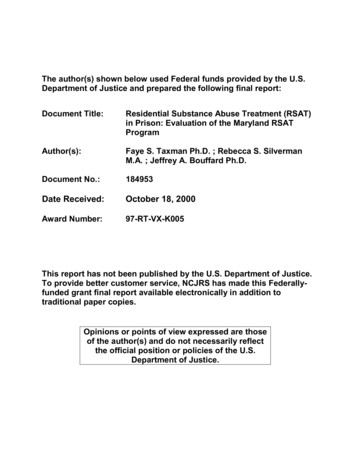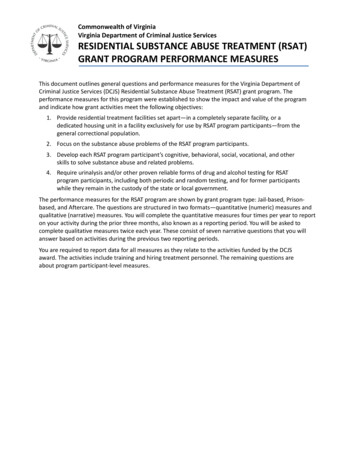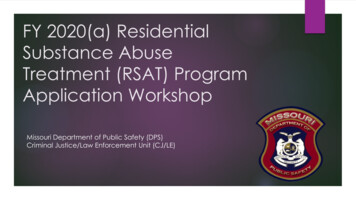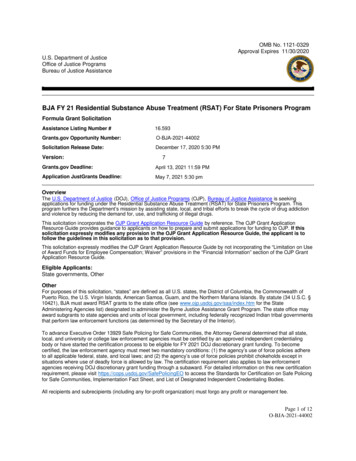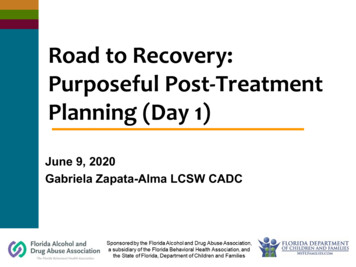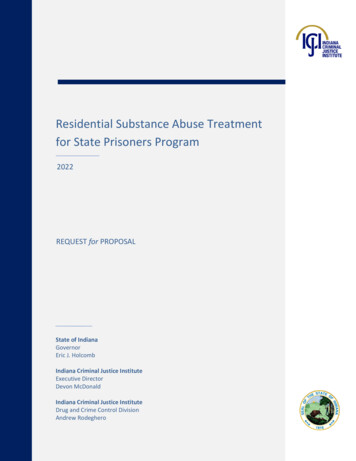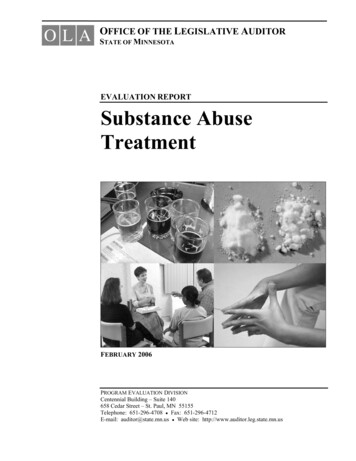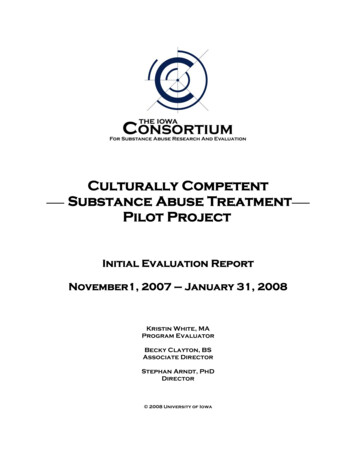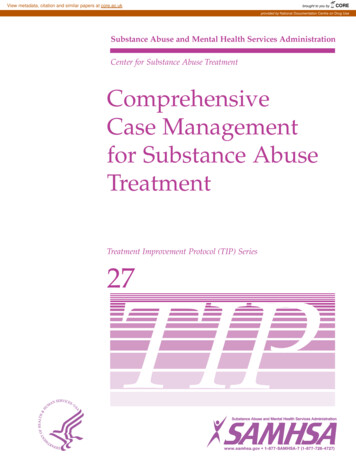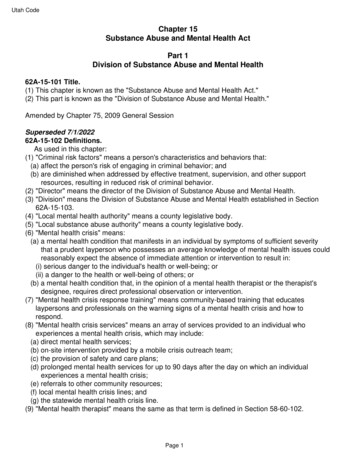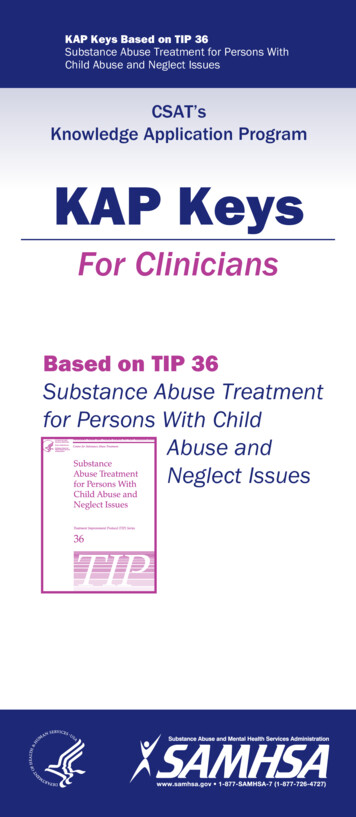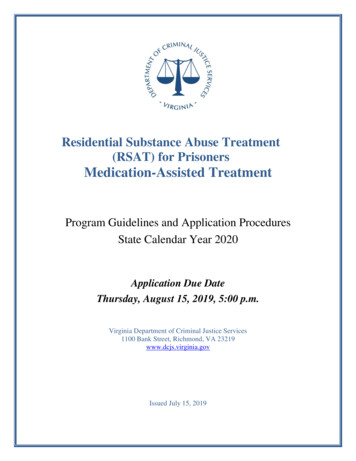
Transcription
Residential Substance Abuse Treatment(RSAT) for PrisonersMedication-Assisted TreatmentProgram Guidelines and Application ProceduresState Calendar Year 2020Application Due DateThursday, August 15, 2019, 5:00 p.m.Virginia Department of Criminal Justice Services1100 Bank Street, Richmond, VA 23219www.dcjs.virginia.govIssued July 15, 2019
Residential Substance Abuse Treatment (RSAT) for PrisonersMedication Assisted TreatmentProgram Guidelines and Application ProceduresTable of ContentsI.Introduction . 3II. Restrictions . 3III. Eligibility, Program Requirements, Due Dates, and Other Information . 3A. Available Funding . 3B.Eligibility . 4C. Program Requirements. 4D. Financial and Progress Reporting . 5E.Disbursement of Funds . 5F.Match Requirement . 5G. Application Deadline . 5H. Technical Assistance . 6I.Grant Application Review Process . 6IV. Application Forms and Instructions . 6A. Grant Application Coversheet. 6B.Project Itemized Budget and Narrative: . 7C. Project Narrative: . 10V. Application Checklist . 142
Residential Substance Abuse Treatment (RSAT) for PrisonersMedication Assisted TreatmentProgram Guidelines and Application ProceduresI. IntroductionThe Virginia Department of Criminal Justice Services (DCJS) is accepting applications forthe federal Residential Substance Abuse Treatment (RSAT) for Prisoners Grant Program.These RSAT grant funds will provide evidence-based residential Medication-AssistedTreatment (MAT) services in local and regional jails. MAT is the use of medications such asBuprenorphine, Methadone, or Naltrexone, coupled with counseling and behavioral therapiesto treat substance use disorders. MAT is primarily used to treat addiction to opioids such asheroin and prescription pain relievers that contain opiates. More information on MAT can befound at nt/treatment.II. RestrictionsGrant recipients may not use these grant funds for: Land acquisition or capital projectsLobbying or political contributionsHonoraria or bonusesPersonal entertainmentPurchasing food and beveragesIII. Eligibility, Program Requirements, Due Dates, and Other InformationA. Available FundingA total of 400,000 in federal Residential Substance Abuse Treatment (RSAT) for PrisonersGrant Program funding is available to assist localities plan for, implement, or enhanceexisting MAT programs in local or regional jails. Funding will support the following projects:1. MAT Planning- Applicants submitting a planning grant may apply for up to 75,000in federal RSAT funds for a planning year to prepare for the implementation ofMAT. Successful applicants will be eligible to apply for a three-yearimplementation grant after the planning process. Applicants should describe theplanning activities that will take place in the initial year of funding2. Program Implementation- Applicants submitting an implementation grant mayapply for up to 200,000 in federal RSAT funds. Applicants must demonstrateprogram readiness to assess and accept participants into the MAT program.Applicants should fully describe program services and the ability to collectperformance measures on program activities.3. Program Enhancement – Applicants submitting a program enhancement grant mayapply for up to 25,000 in federal RSAT funds. Applicants must have a currentRSAT MAT funded program. Applicants must justify the need for an enhancementApplicants will be funded for 18 months beginning, January 1, 2020, through June 30, 2021.Continuation of funding for additional years is subject to program performance andavailability of federal funding.3
Residential Substance Abuse Treatment (RSAT) for PrisonersMedication Assisted TreatmentProgram Guidelines and Application ProceduresB. EligibilityLocal and regional jails are eligible to apply for RSAT funding. Awards will be madethrough a competitive grant review process. Only those applicants offering programs thatinclude a combination of medication and behavioral therapies will be considered.C. Program RequirementsRSAT grant funds must be used to plan for, implement, or enhance residential MATprograms that provide individual and group therapeutic and vocational activities forparticipants in residential facilities operated by local or regional correctional agencies. Jailbased residential MAT programs must: Utilize a validated risk and needs assessment that will form the basis of anindividualized treatment plan. A risk and needs assessment is an instrument tohelp identify factors that may lead a participant to reoffend. It should pinpointneeded services to minimize those risks. More information about riskassessments and effective evidence-based practices can be found T44.pdfEngage inmates for at least 3 monthsFocus on the inmate’s substance abuse diagnosis and addiction-related needsRequire urinalysis and/or other proven reliable forms of drug and alcohol testing forprogram participants, including both periodic and random testing, and for formerparticipants while they remain in the custody of the state or local governmentPrepare offenders for successful community reintegration that may include postrelease referral to appropriate evidence-based aftercare treatment and/or serviceproviders, including those that support the use of medication-assisted treatmentProvide MAT practices and services that have a demonstrated evidence baseand are appropriate for the target population. This shall include medicationassisted treatment (i.e. the use of at least one antagonist (e.g. Naltrexone),agonist (e.g. Methadone), or partial-agonist medication (e.g. Buprenorphine))in coordination with evidence-based cognitive behavioral treatmentincorporated into group and individualized counseling, case planning, and peersupport, as well as intensive reentry servicesSeparate jail-based treatment population from the general correctionalpopulation. Pods or wings of housing units are acceptable methods forseparating the treatment population from the general populationBy applying for these grant funds, the applicant asserts that they have read, understand, andwill comply with the following state and federal requirements and policies: Civil Rights: ation: http://ojp.gov/about/ocr/assistance.htmLimited English Proficiency Individuals:https://www.lep.gov/guidance/guidance DOJ Guidance.htmlEqual Opportunity Plans: https://ojp.gov/about/ocr/eeop.htm4
Residential Substance Abuse Treatment (RSAT) for PrisonersMedication Assisted TreatmentProgram Guidelines and Application Procedures Department of Justice Financial nloadD. Financial and Progress ReportingDCJS requires online submission of quarterly financial and progress reports into the GrantsManagement Information System (GMIS); therefore, all recipients of grant funding musthave access to the Internet for reporting purposes. Additional information about the on-linereporting system can be found on the DCJS website e.Failure to comply in a timely manner may result in DCJS withholding disbursement of grantfunds and/or termination of the grant. DCJS will provide grant-reporting requirements at thetime of grant award.E. Disbursement of FundsThe federal government requires that disbursement of these funds only occur on a costreimbursement basis for actual funds expended. Actual expenditures should be reportedquarterly and invoiced pursuant to approved line item budget categories in the grant awardpackage. Grantees will only be reimbursed for costs that have been incurred within the grantperiod. Grant funds may only be expended and/or obligated during the grant period. Allobligations must be fulfilled no later than 90 days after the end of the grant period. Requestsfor reimbursement shall be submitted through DCJS GMIS.F. Match RequirementThe federal RSAT grant guidelines require a 25 percent cash match. The federal share of agrant-funded project may not exceed 75 percent of the total costs of the project. The 25percent cash match must be from non-federal sources and be included in each item of thebudget worksheet and budget narrative. Match funds included in the grant budget are subjectto the same requirements and conditions that apply to the federal funds awarded by DCJS.G. Application DeadlineApplications must be emailed to grantsmgmt@dcjs.virginia.gov no later than 5:00 p.m. onAugust 15, 2019. Applications received after the deadline will not be considered unlesstechnical issues with the submission are documented by the applicant and accepted byDCJS. Early submissions are appreciated.5
Residential Substance Abuse Treatment (RSAT) for PrisonersMedication Assisted TreatmentProgram Guidelines and Application ProceduresH. Technical AssistanceFor guidance on preparing and submitting a grant application, please contact Aja Ferguson at804-225-4127 or aja.ferguson@dcjs.virginia.I. Grant Application Review ProcessThis is a competitive grant application process in which each applicant will be competingagainst other applicants. Staff from DCJS and DBHDS will evaluate and score eachapplication based on information provided, and the clarity, substance, and strength of therequest made for funding. Reviewers may consider past performance, geographic location,budget justification, cost effectiveness of proposed projects, and the availability of funds.DCJS may amend budgets based on a review of unallowable and/or unreasonable costs, andthe availability of funds. DCJS has the discretion to make awards for greater or lesseramounts than requested and to negotiate the scope of work and budget with applicants priorto making an award.Each application can earn a weighted total maximum score of 60 points. The primary grantprogram elements are evaluated based on ratings of Excellent, Acceptable, Marginal, orUnacceptable. The weighted rating points that can be awarded for each primary grantprogram element are: Itemized Budget (10%)Budget Narrative (15%)Needs Justification (20%)Project Description (20%)Implementation Steps (15%)Goals and Objectives (15%)Technical Compliance (5%)0-6 points0-9 points0-12 points0-12 points0-9 points0-9 points0-3 pointsThe Grants Committee of the Criminal Justice Services Board (CJSB) will review grantapplication scores and recommendations and make funding recommendations to the CJSB.The CJSB will make final grant award decisions at its meeting on October 10, 2019.DCJS Office of Grants Management in the Division of Finance and Administration will issuegrant award packages based on the final approval of the CJSB. Fiscal and programmaticrevisions may be required as a condition of funding.IV. Application Forms and InstructionsA. Grant Application CoversheetThe first page of the application is the Grant Application Coversheet. Use of the GrantApplication Coversheet template form is required. Complete the following items.Congressional Districts: List the congressional districts that will benefit from the program.6
Residential Substance Abuse Treatment (RSAT) for PrisonersMedication Assisted TreatmentProgram Guidelines and Application ProceduresApplicant: Official name of organization applying for the grant.Faith-Based Organization: Check the box indicating whether or not your program is a faithbased organization.Federal ID Number: List your locality/agency federal identification number.Best Practice: Not applicable to this grant program.Jurisdiction(s): List all localities to be served and include zip code plus 4 digit code.Program Title: Indicate program title, i.e. “RSAT Grant”Certified Crime Prevention Community: Not applicable to this grant program.DUNS Number: Provide the Data Universal Numbering (DUNS) Number. A DUNS numberis a unique nine-character identification number provided by Dun & Bradstreet. If you do nothave a DUNS number, please go the website http://fedgov.dnb.com/webform.Rural, Urban or Suburban: Check the box that best describes the applicant service area.Project Director: List the person who will have day-to-day responsibility for managing theproject.Project Administrator: The person who has authority to formally commit the organization,locality, or state agency to complying with all the terms of the grant application, includingthe provision of the required match. This must be the president of the Board of Directors of anonprofit organization; the city, county or town manager; the chief elected officer of thelocality, such as the Mayor or Chairman of the Board of Supervisors; or, in the case of a stateagency, the agency head. If someone other than one of these officials has been delegated theauthority to sign, and signs the grant application, provide a copy of the letter, memorandumor other document by which the signing authority was delegated.Finance Officer: List the individual who will be responsible for fiscal management of thefunds.Be sure to provide email addresses and phone numbers for each of the three people listedabove. Also provide the zip code plus 4 digit code for each person.Signature of Project Administrator: This field must be completed with an actual signature,not a typed name.Brief Project Description: Provide a short description of the project. The description mustinclude an estimate of the total number of individuals to receive program services during thecalendar year and a brief summary of services to be provided.Project Budget Summary: The Budget Summary provides total figures from budgetcategories. These figures should match the Itemized Budget sheets.B. Project Itemized Budget and Narrative:The budget narrative should explain the reason for each requested budget item and providethe calculation basis for its cost. All requested items must be justified and related to RSATactivities.7
Residential Substance Abuse Treatment (RSAT) for PrisonersMedication Assisted TreatmentProgram Guidelines and Application ProceduresAll additional funds supporting the program must be included in the itemized budget in eachline item under “Cash” and in Section 7 of the itemized budget form under “Cash Funds,”and in the budget as narrative appropriate. All amounts must be rounded to the nearest dollar.Cash match is defined as direct funding for the project obtained from local government fundsor private sources.1. Personnel/EmployeesList each position by title (and name of employee, if available). Column 4, “TotalSalary Amount Requested from Grant” refers to grant-funded salary amountsrequested from the grant (do not include fringe benefits here). Show the annual andhourly salary rates for the employee, and the hours to be devoted to the project by theemployee. Typically, full-time employees work 2,080 hours annually.The position description should describe grant-related duties performed. Additionally,please indicate in the position description whether this position is a current and filledposition, a current yet un-filled position, or a new, proposed position. Indicate eachtype of benefit included and the total cost to employees assigned to the project.The justification should explain how the position is essential and allowable under theRSAT Grant Guidelines. Applicants must justify all requested salaries. Justificationmay include documentation demonstrating that requested salaries are consistent withsalaries paid to other positions with similar responsibilities, within the program, or atother organizations in the service area. All requested amounts must be reasonablegiven the complexity of work, and consistent with the applicant’s staff compensationplan.2. ConsultantsList each type of consultant or service, the proposed hourly fee rate, the amount oftime to be devoted to such services, and the total cost requested. Document how theuse of outside consultants will significantly enhance project effectiveness and thatconsultant use is cost effective. For Individual Consultants: the rate may not exceed 650.00 per day ( 81.25 per hour).For organizations performing professional services, including professionalassociations and educational institutions, indicate the type of services beingperformed and estimated hourly contract price.Travel and Subsistence for Consultants: Reasonable expenses may be reimbursed.3. TravelItemize total travel expenses of project personnel by local mileage, non-local mileage,and subsistence (food and lodging). If the applicant does not have an established localtravel policy, then the applicant must adhere to federal/state travel policy. If local8
Residential Substance Abuse Treatment (RSAT) for PrisonersMedication Assisted TreatmentProgram Guidelines and Application Procedurestravel policy differs from the federal/state travel policy, please provide or describe thepolicy in the justification. Refer to the following U.S. General ServicesAdministration (GSA) and Virginia Department of Accounts (DOA) websites for themost current travel rates and eswww.doa.virginia.gov/Clearly explain the basis for all calculations. The mileage/travel reimbursement mustbe for the support of the RSAT grant.If funding is available, DCJS will consider requests to support attendance atappropriate national training conferences. Applicants must document that therequested training is needed and is unavailable within the state. Registration feeexpenses should be detailed in the “Supplies and Other Expenses” category. DCJSmay approve requests for funds to support out-of-state travel, or airfares to attendtraining conferences, with adequate justification. Applicants should demonstrate thatattendance is cost effective and will facilitate essential improvements in servicedelivery.Local mileage is considered travel within the immediate service area (satelliteoffices, court, meetings, etc.). Non-local mileage is outside of the immediate servicearea (trainings, conferences, meetings, etc.). Include a description for each requestand justify why the request is necessary.4. EquipmentEquipment includes, but is not limited to, the purchase or lease of items suchcomputers, telephones (but not line service), and cellular phones. Each major item tobe purchased must be listed separately with unit cost. Each item to be leased or rentedmust be listed separately with the cost associated with the lease or rental. The budgetnarrative must explain the relevance of each item to the project. Items not justifiedwill not be funded.5. Supplies and Other Operating ExpensesAll costs should be itemized within this category by major types with the basis forcomputation (“x” dollars per month, “y” dollars per person, etc.). If necessary, majorexpenses can be itemized within major categories in each subheading withjustification in the narrative. Other Operating Expenses include, but are not limited to,the following: telephone services, internet access/internet provider contracts, cellularphone services, office supplies, training, postage, and printing projects.6. Indirect CostsThese are costs that cannot be assigned to a particular category but are necessary to9
Residential Substance Abuse Treatment (RSAT) for PrisonersMedication Assisted TreatmentProgram Guidelines and Application Proceduresthe operation of the organization and the performance of the project. Indirect costswill only be approved if the applicant has an approved rate from a cognizant federalagency. A copy of that approval must be submitted with the grant application.7. Non-SupplantationThe federal Department of Justice (DOJ) 2017 Grants Financial Guide describessupplantation as follows: “Federal funds must be used to supplement existing stateand local funds for program activities and must not supplant (replace) those funds thathave been appropriated for the same purpose.” Requests for “new” staff positionsmust be justified, must not supplant other funds, and must result in significantadditional service delivery.Applicants under this grant program must describe non-grant funds supporting theirprojects and must identify records that document the level of non-RSAT support andsatisfy the non-supplantation requirement. Be sure to describe whether the expensesrequested in this grant application compliment, and do not duplicate, other existingand anticipated funding sources/amounts.C. Project Narrative:1. Planning Grants (To be completed by planning grant applicants only)a. Program Goals: Applicants should indicate the goals of the MATprogram. Describe activities such as meetings, trainings, site visits,development of policies and procedures, development of memorandumsof understanding, and other planning activities. Discuss how theseactivities will assist your agency in planning for programimplementation. Identify which potential medication(s) will be utilized,how the applicant plans to address organizational capacity toaccommodate the use of MAT (storage, administration, compliance withfederal and state laws and regulations, as well as staff competencethrough training and/or licensing). Provide timelines of activities andpersons responsible for executing those timelines. Explanation ofprogram goals may be up to three pages in length.b. Evidence-Based Treatment Practices: The following programcomponents should be described in the Evidence-Based TreatmentPractices Section of Program Narrative:i. Screening and Assessment: Include a description of the process bywhich participants will be identified, screened, and assessed as wellas the application of a risk assessment tool.ii. Treatment Modalities and Practices: Applicants must utilizerecognized peer reviewed publications and/or national leadingcriminal justice and behavioral health organizations to develop10
Residential Substance Abuse Treatment (RSAT) for PrisonersMedication Assisted TreatmentProgram Guidelines and Application Procedurestreatment modalities and practices (such as the Substance Abuseand Mental Health Services Administration-SAMHSA, NationalInstitute on Drug Abuse-NIDA, National Institute on AlcoholAbuse and Alcoholism-NIAAA, and the National Association ofDrug Court Professionals-NADCP).Additional information about effective and promising practices forthe application of substance abuse treatment for the criminal justicepopulation can be found at the following websites: the NationalInstitute of Justice (https://www.crimesolutions.gov/default.aspx),the American Society of Addiction Medicine(https://www.asam.org/), and the Training and Technical Assistancewebsite for the Residential Substance Abuse Treatment forParticipants grant program (http://www.rsat-tta.com/Home).iii. The program must utilize at least one antagonist (e.g. Naltrexone),agonist (e.g. Methadone), or partial-agonist medication (e.g.Buprenorphine) in coordination with other evidence-basedbehavioral treatment components. Applicants should describe themedication(s) that will be utilized and evidence to support itsefficacy with the target population and must demonstrate capacityto meet all federal and state regulatory requirements governing theprescribing, storage, dispensing, and administering of thesemedications. SAMHSA provides Treatment Improvement Protocols(TIPs) that describes these standards and regulations. TIPs 40, 43and 63 should be adhered to when providing MAT. They can befound on the SAMHSA website at https://store.samhsa.gov.c. Program Coordination: An explanation of how the agency willcoordinate the RSAT project at the local level. Examples includecoordination with local probation offices, community service boards,drug treatment courts, service providers, and peer support organizations.Partnerships with local service providers are encouraged. Include lettersof intent to demonstrate planning activities as attachments. This portionmay be up to two pages in length.d. Program Sustainability: RSAT funding is awarded based on programcompliance, as well as the availability of federal funds. Please provide aplan for how the agency/locality will programmatically and financiallysustain any proposed residential treatment program. Describe how thisproject will utilize community partners and stakeholders that have avested interest in the success of the proposed residential treatmentprogram. This portion may be one page in length.e. Award Disclosure: A description of any current or pending federal orstate awards which also will support MAT program efforts. Include howthese awards will be coordinated with the funding sought by thisapplication. For each include the program/project title, the grantor11
Residential Substance Abuse Treatment (RSAT) for PrisonersMedication Assisted TreatmentProgram Guidelines and Application Proceduresagency, the award amount, and a very brief description of its purpose.This portion may be up to two pages in length.f. Data Collection: During the planning year, grantees will not be requiredto submit program specific data as the program will not yet beoperational. However, during the planning phase programs will berequired to develop a detailed plan for collecting and reportingperformance measures, data, and outcome measures.2. Implementation Grants: (to be completed by implementation and enhancementgrant applicants only)a. Program Goals: Applicants should indicate the overall goals of the MATprogram. This section should include the ongoing implementationprocess and a timetable for implementation with persons responsible foractivities. Specify which medication(s) will be utilized, how theapplicant plans to address organizational capacity to accommodate theuse of MAT (storage, administration, compliance with federal and statelaws and regulations, as well as staff competence through training and/orlicensing). Information on priorities and/or special activities to befunded, including a description of how the preference for programs withaftercare services will be implemented. Explanation of program goalsmay be up to three pages in length.b. Evidence-Based Treatment Practices: The following programcomponents should be described in the Evidence-Based TreatmentPractices Section of Program Narrative:i. Screening and Assessment: Include a description of the process bywhich participants are identified, screened, and assessed as well asthe application of a risk assessment tool. Identify and discuss theevidence that shows the practice is effective. Examples of how theparticipants will be educated about the use of MAT and its impacton their health and likely treatment outcomes should also beincluded.ii. Treatment Modalities and Practices: Applicants must utilizerecognized peer reviewed publications and/or national leadingcriminal justice and behavioral health organizations to developtreatment modalities and practices (such as the Substance Abuseand Mental Health Services Administration-SAMHSA, NationalInstitute on Drug Abuse-NIDA, National Institute on AlcoholAbuse and Alcoholism-NIAAA, and the National Association ofDrug Court Professionals-NADCP).Additional information about effective and promising practices forthe application of substance abuse treatment for the criminal justicepopulation can be found at the following websites: the National12
Residential Substance Abuse Treatment (RSAT) for PrisonersMedication Assisted TreatmentProgram Guidelines and Application ProceduresInstitute of Justice (https://www.crimesolutions.gov/default.aspx),the American Society of Addiction Medicine(https://www.asam.org/), and the Training and Technical Assistancewebsite for the Residential Substance Abuse Treatment forParticipants grant program (http://www.rsat-tta.com/Home).iii.The program must utilize at least one antagonist (e.g. Naltrexone),agonist (e.g. Methadone), or partial-agonist medication (e.g.Buprenorphine), in coordination with other evidence-basedbehavioral treatment components. Applicants should describe themedication(s) that will be utilized and evidence to support itsefficacy with the target population and must demonstrate capacityto meet all federal and state regulatory requirements governing theprescribing, storage, dispensing, and administering of thesemedications. SAMHSA provides Treatment Improvement Protocols(TIPs) that describes these standards and regulations. TIPs 40, 43and 63 should be adhered to when providing MA
Goals and Objectives (15%) 0-9 points Technical Compliance (5%) 0-3 points The Grants Committee of the Criminal Justice Services Board (CJSB) will review grant application scores and recommendations and make funding recommendations to the CJSB. . Residential Substance Abuse Treatment (RSAT) for Prisoners Medication Assisted Treatment .
